Topic 3: City Power & Light
Case study
This is a case study. Case studies are not timed separately. You can use as much
exam time as you would like to complete each case. However, there may be additional
case studies and sections on this exam. You must manage your time to ensure that you
are able to complete all questions included on this exam in the time provided.
To answer the questions included in a case study, you will need to reference information
that is provided in the case study. Case studies might contain exhibits and other resources
that provide more information about the scenario that is described in the case study. Each
question is independent of the other questions in this case study.
At the end of this case study, a review screen will appear. This screen allows you to review
your answers and to make changes before you move to the next section of the exam. After
you begin a new section, you cannot return to this section.
To start the case study
To display the first question in this case study, click the Next button. Use the buttons in the
left pane to explore the content of the case study before you answer the questions. Clicking
these buttons displays information such as business requirements, existing environment,
and problem statements. When you are ready to answer a question, click the Question
button to return to the question.
Background
City Power & Light company provides electrical infrastructure monitoring solutions for
homes and businesses. The company is migrating solutions to Azure.
Current environment
Architecture overview
The company has a public website located at http://www.cpandl.com/. The site is a singlepage
web application that runs in Azure App Service on Linux. The website uses files
stored in Azure Storage and cached in Azure Content Delivery Network (CDN) to serve
static content.
API Management and Azure Function App functions are used to process and store data in
Azure Database for PostgreSQL. API Management is used to broker communications to
the Azure Function app functions for Logic app integration. Logic apps are used to
orchestrate the data processing while Service Bus and Event Grid handle messaging and
events.
The solution uses Application Insights, Azure Monitor, and Azure Key Vault.
Architecture diagram
The company has several applications and services that support their business. The
company plans to implement serverless computing where possible. The overall architecture
is shown below.

User authentication
The following steps detail the user authentication process:
The user selects Sign in in the website.
The browser redirects the user to the Azure Active Directory (Azure AD) sign in
page.
The user signs in.
Azure AD redirects the user’s session back to the web application. The URL
includes an access token.
The web application calls an API and includes the access token in the
authentication header. The application ID is sent as the audience (‘aud’) claim in
the access token.
The back-end API validates the access token.
Requirements
Corporate website
Communications and content must be secured by using SSL.
Communications must use HTTPS.
Data must be replicated to a secondary region and three availability zones.
Data storage costs must be minimized.
Azure Database for PostgreSQL
The database connection string is stored in Azure Key Vault with the following attributes:
Azure Key Vault name: cpandlkeyvault
Secret name: PostgreSQLConn
Id: 80df3e46ffcd4f1cb187f79905e9a1e8
The connection information is updated frequently. The application must always use the
latest information to connect to the database.
Azure Service Bus and Azure Event Grid
Azure Event Grid must use Azure Service Bus for queue-based load leveling.
Events in Azure Event Grid must be routed directly to Service Bus queues for use
in buffering.
Events from Azure Service Bus and other Azure services must continue to be
routed to Azure Event Grid for processing.
Security
All SSL certificates and credentials must be stored in Azure Key Vault.
File access must restrict access by IP, protocol, and Azure AD rights.
All user accounts and processes must receive only those privileges which are
essential to perform their intended function.
Compliance
Auditing of the file updates and transfers must be enabled to comply with General Data
Protection Regulation (GDPR). The file updates must be read-only, stored in the order in
which they occurred, include only create, update, delete, and copy operations, and be
retained for compliance reasons.
Issues
Corporate website
While testing the site, the following error message displays:
CryptographicException: The system cannot find the file specified.
Function app
You perform local testing for the RequestUserApproval function. The following error
message displays:
'Timeout value of 00:10:00 exceeded by function: RequestUserApproval'
The same error message displays when you test the function in an Azure development
environment when you run the following Kusto query:
FunctionAppLogs
| where FunctionName = = "RequestUserApproval"
Logic app
You test the Logic app in a development environment. The following error message
displays:
'400 Bad Request'
Troubleshooting of the error shows an HttpTrigger action to call the RequestUserApproval
function.
Code
Corporate website
Security.cs:

You need to retrieve the database connection string.
Which values should you use? To answer, select the appropriate options in the answer
area.
NOTE: Each correct selection is worth one point.


Azure database connection string retrieve REST API vault.azure.net/secrets/
Box 1: cpandlkeyvault
We specify the key vault, cpandlkeyvault.
Scenario: The database connection string is stored in Azure Key Vault with the following
attributes:
Azure Key Vault name: cpandlkeyvault
Secret name: PostgreSQLConn
Id: 80df3e46ffcd4f1cb187f79905e9a1e8
Box 2: PostgreSQLConn
We specify the secret, PostgreSQLConn
Example, sample request:
https://myvault.vault.azure.net//secrets/mysecretname/4387e9f3d6e14c459867679a90fd0f
79?api-version=7.1
Box 3: Querystring
ASP.NET Core API app by using C#. The API app will allow users to authenticate by using Twitter and Azure Active Directory (Azure AD).
Users must be authenticated before calling API methods. You must log the user’s name for
each method call.
You need to configure the API method calls.
Which values should you use? To answer, select the appropriate options in the answer
area.
NOTE: Each correct selection is worth one point.

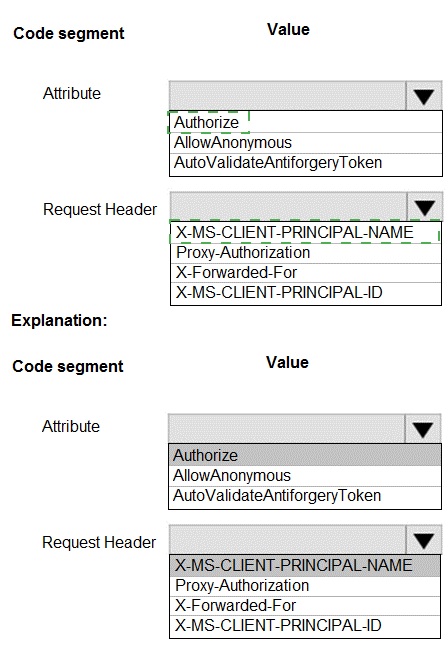
+ Explanation:
Box 1: Authorize
Box 2: X-MS-CLIENT-PRINCIPAL-NAME
App Service passes user claims to your application by using special headers. External
requests aren't allowed to set these headers, so they are present only if set by App
Service. Some example headers include:
X-MS-CLIENT-PRINCIPAL-NAME
X-MS-CLIENT-PRINCIPAL-ID
Here's the set of headers you get from Easy Auth for a Twitter authenticated user:
{
"cookie": "AppServiceAuthSession=Lx43...xHDTA==",
"x-ms-client-principal-name": "evilSnobu",
"x-ms-client-principal-id": "35....",
"x-ms-client-principal-idp": "twitter",
"x-ms-token-twitter-access-token": "35...Dj",
"x-ms-token-twitter-access-token-secret": "OK3...Jx",
}
References:
https://docs.microsoft.com/en-us/azure/app-service/app-service-authentication-how-to
Note: This question is part of a series of questions that present the same scenario.
Each question in the series contains a unique solution that might meet the stated
goals. Some question sets might have more than one correct solution, while others
might not have a correct solution.
After you answer a question in this section, you will NOT be able to return to it. As a
result, these questions will not appear in the review screen.
You are developing an Azure solution to collect point-of-sale (POS) device data from 2,000
stores located throughout the world. A single device can produce 2 megabytes (MB) of
data every 24 hours. Each store location has one to five devices that send data.
You must store the device data in Azure Blob storage. Device data must be correlated
based on a device identifier. Additional stores are expected to open in the future.
You need to implement a solution to receive the device data.
Solution: Provision an Azure Notification Hub. Register all devices with the hub.
Does the solution meet the goal?
A.
Yes
B.
No
No
Instead use an Azure Service Bus, which is used order processing and financial
transactions.
Reference:
https://docs.microsoft.com/en-us/azure/event-grid/compare-messaging-services
You are preparing to deploy a Python website to an Azure Web App using a container. The
solution will use multiple containers in the same container group. The Dockerfile that builds
the container is as follows:

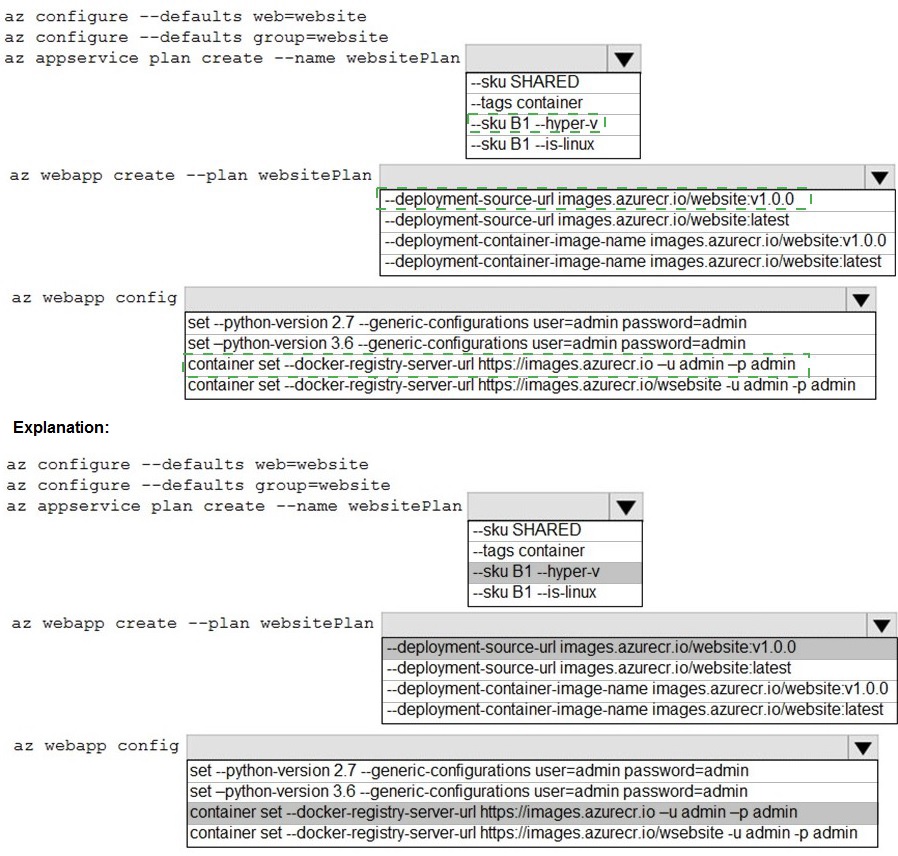
Box 1: -SKU B1 -hyper-v
-hyper-v
Host web app on Windows container.
Box 2: -deployment-source-url images.azurecr.io/website:v1.0.0
-deployment-source-url -u
Git repository URL to link with manual integration.
The Web App must always run the same version of the website regardless of future builds.
Incorrect:
-deployment-container-image-name -i
Linux only. Container image name from Docker Hub, e.g. publisher/image-name:tag.
Box 3: az webapp config container set -url https://images.azurecr.io -u admin -p admin
az webapp config container set
Set a web app container's settings.
Paremeter: -docker-registry-server-url -r
The container registry server url.
The Azure Container Registry instance named images is a private registry.
Example:
az webapp config container set -docker-registry-server-url https://{azure-container-registryname}.
azurecr.io
You are developing a medical records document management website. The website is
used to store scanned copies of patient intake forms. If the stored intake forms are
downloaded from storage by a third party, the content of the forms must not be
compromised.
You need to store the intake forms according to the requirements.
Solution:
uk.co.certification.simulator.questionpool.PList@ed015f0
Does the solution meet the goal?
A.
Yes
B.
No
No
You are developing a new page for a website that uses Azure Cosmos DB for data storage.
The feature uses documents that have the following format:
You must display data for the new page in a specific order. You create the following query
for the page:
You need to configure a Cosmos DB policy to the support the query.
How should you configure the policy? To answer, drag the appropriate JSON segments to
the correct locations. Each JSON segment may be used once, more than once, or not at
all. You may need to drag the split bar between panes or scroll to view content.
NOTE: Each correct selection is worth one point.
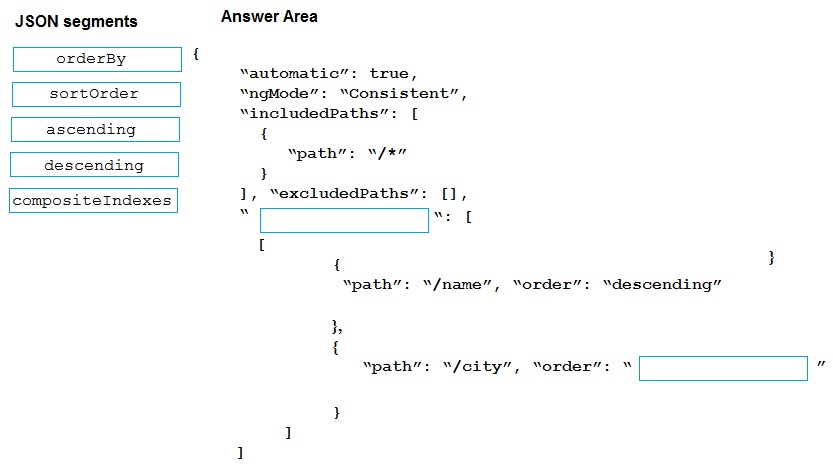

Box 1: compositeIndexes
You can order by multiple properties. A query that orders by multiple properties requires a
composite index.
Box 2: descending
Example: Composite index defined for (name ASC, age ASC):
It is optional to specify the order. If not specified, the order is ascending.
{
"automatic":true,
"indexingMode":"Consistent",
"includedPaths":[
{
"path":"/*"
}
],
"excludedPaths":[],
"compositeIndexes":[
[
{
"path":"/name",
},
{
"path":"/age",
}
]
]
}
You develop an Azure web app. You monitor performance of the web app by using
Application Insights. You need to ensure the cost for Application Insights does not exceed
a preset budget. What should you do?
A.
Implement ingestion sampling using the Azure portal
B.
Set a daily cap for the Application Insights instance.
C.
Implement adaptive sampling using the Azure portal.
D.
Implement adaptive sampling using the Application Insights SDK.
E.
Implement ingestion sampling using the Application Insights SDK
Implement adaptive sampling using the Application Insights SDK.
Sampling is an effective way to reduce charges and stay within your monthly quota.
You can set sampling manually, either in the portal on the Usage and estimated costs
page; or in the ASP.NET SDK in the .config file; or in the Java SDK in the
ApplicationInsights.xml file, to also reduce the network traffic.
Adaptive sampling is the default for the ASP.NET SDK. Adaptive sampling automatically
adjusts to the volume of telemetry that your app sends. It operates automatically in the
SDK in your web app so that telemetry traffic on the network is reduced.
References:
https://docs.microsoft.com/en-us/azure/azure-monitor/app/sampling
You are developing an application that needs access to an Azure virtual machine (VM).
The access lifecycle for the application must be associated with the VM service instance.
You need to enable managed identity for the VM.
How should you complete the PowerShell segment? To answer, select the appropriate
options in the answer area.
NOTE Each correct selection is worth one point.


Explanation:
$vm = Get-AzVM -ResourceGroupName myResourceGroup -Name myVM
Update-AzVM -ResourceGroupName myResourceGroup -VM $vm -
AssignIdentity:$SystemAssigned
https://docs.microsoft.com/en-us/azure/active-directory/managed-identities-azureresources/
qs-configure-powershell-windows-vm
Note: This question is part of a series of questions that present the same scenario. Each
question in the series contains a unique solution that might meet the stated goals. Some
question sets might have more than one correct solution, while others might not have a
correct solution.
After you answer a question in this section, you will NOT be able to return to it. As a result,
these questions will not appear in the review screen.
You are developing an Azure solution to collect point-of-sale fPOS) device data from 2,000
stores located throughout the world. A single device can produce 2 megabytes (MB) of
data every 24 hours. Each store location has one to five devices that send data.
You must store the device data in Azure Blob storage. Device data must be correlated
based on a device identifier. Additional stores are expected to open in the future.
You need to implement a solution to receive the device data.
Solution: Provision an Azure Event Hub. Configure the machine identifier as the partition
key and enable capture.
A.
Yes
B.
No
Yes
You are deploying an Azure Kubernetes Services (AKS) cluster that will use multiple
containers.
You need to create the cluster and verify that the services for the containers are configured
correctly and available.
Which four commands should you use to develop the solution? To answer, move the
appropriate command segments from the list of command segments to the answer area
and arrange them in the correct order.

Step 1: az group create
Create a resource group with the az group create command. An Azure resource group is a
logical group in which Azure resources are deployed and managed.
Example: The following example creates a resource group named myAKSCluster in the
eastus location.
az group create -name myAKSCluster -location eastus
Step 2 : az aks create
Use the az aks create command to create an AKS cluster.
Step 3: kubectl apply
To deploy your application, use the kubectl apply command. This command parses the
manifest file and creates the defined Kubernetes objects.
Step 4: az aks get-credentials
Configure it with the credentials for the new AKS cluster. Example:
az aks get-credentials -name aks-cluster -resource-group aks-resource-group
References:
https://docs.bitnami.com/azure/get-started-aks/
A company runs an international travel and bookings management service. The company
plans to begin offering restaurant bookings. You must develop a solution that uses Azure
Search and meets the following requirements:
• Users must be able to search for restaurants by name, description, location, and cuisine.
• Users must be able to narrow the results further by location, cuisine, rating, and familyfriendliness.
• All words in descriptions must be included in searches.
You need to add annotations to the restaurant class.
How should you complete the code segment? To answer, select the appropriate options in
the answer area.
NOTE: Each correct selection is worth one point.
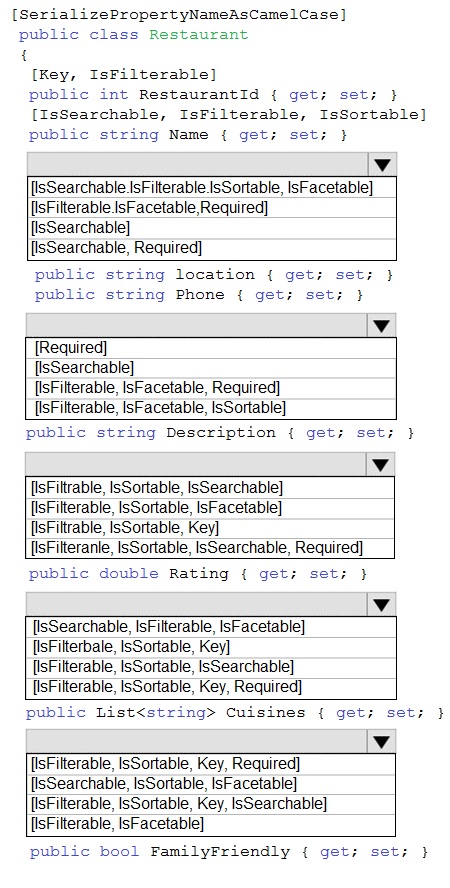

Box 1: [IsSearchable.IsFilterable.IsSortable,IsFacetable]
Location
Users must be able to search for restaurants by name, description, location, and cuisine.
Users must be able to narrow the results further by location, cuisine, rating, and familyfriendliness.
Box 2: [IsSearchable.IsFilterable.IsSortable,Required]
Description
Users must be able to search for restaurants by name, description, location, and cuisine.
All words in descriptions must be included in searches.
Box 3: [IsFilterable,IsSortable,IsFaceTable]
Rating
Users must be able to narrow the results further by location, cuisine, rating, and familyfriendliness.
Box 4: [IsSearchable.IsFilterable,IsFacetable]
Cuisines
Users must be able to search for restaurants by name, description, location, and cuisine.
Users must be able to narrow the results further by location, cuisine, rating, and familyfriendliness.
Box 5: [IsFilterable,IsFacetable]
FamilyFriendly
Users must be able to narrow the results further by location, cuisine, rating, and familyfriendliness.
References:
https://www.henkboelman.com/azure-search-the-basics/
You are developing a serverless Java application on Azure. You create a new Azure Key
Vault to work with secrets from a new Azure Functions application.
The application must meet the following requirements:
Reference the Azure Key Vault without requiring any changes to the Java code.
Dynamically add and remove instances of the Azure Functions host based on the
number of incoming application events.
Ensure that instances are perpetually warm to avoid any cold starts.
Connect to a VNet.
Authentication to the Azure Key Vault instance must be removed if the Azure
Function application is deleted.
You need to grant the Azure Functions application access to the Azure Key Vault.
Which three actions should you perform in sequence? To answer, move the appropriate
actions from the list of actions to the answer area and arrange them in the correct order.
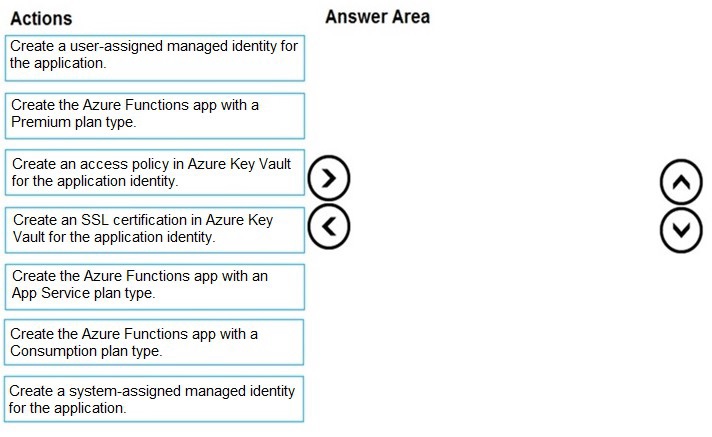
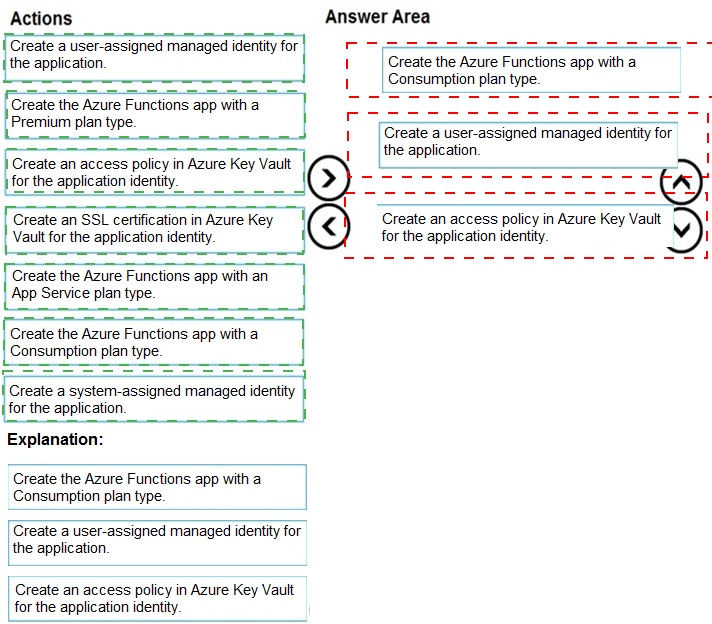
Step 1: Create the Azure Functions app with a Consumption plan type.
Use the Consumption plan for serverless.
Step 2: Create a system-assigned managed identity for the application.
Create a system-assigned managed identity for your application.
Key Vault references currently only support system-assigned managed identities. Userassigned
identities cannot be used.
Step 3: Create an access policy in Key Vault for the application identity.
Create an access policy in Key Vault for the application identity you created earlier. Enable
the "Get" secret permission on this policy. Do not configure the "authorized application" or
applicationId settings, as this is not compatible with a managed identity.
| Page 3 out of 23 Pages |
| Previous |